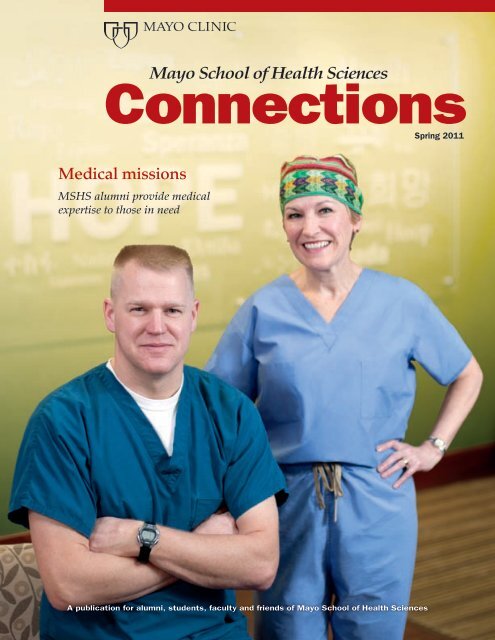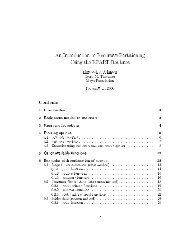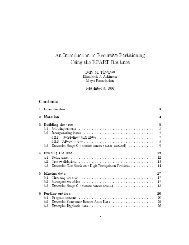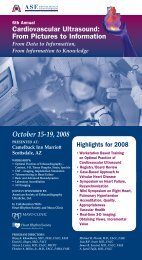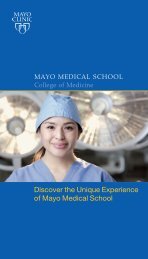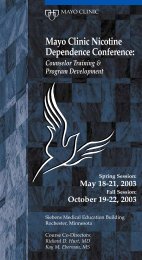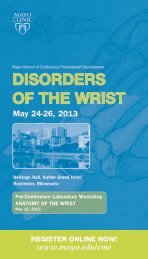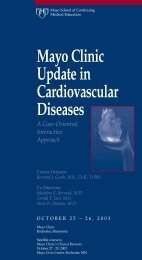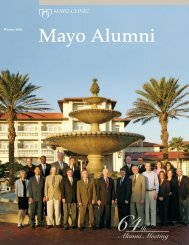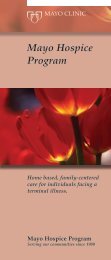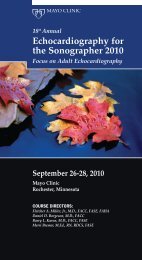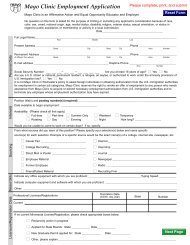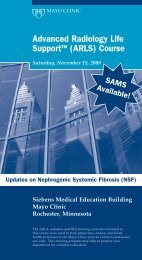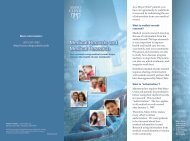MSHS Alumni Connection Mag SP 11 - MC4192-0311 - Mayo Clinic
MSHS Alumni Connection Mag SP 11 - MC4192-0311 - Mayo Clinic
MSHS Alumni Connection Mag SP 11 - MC4192-0311 - Mayo Clinic
Create successful ePaper yourself
Turn your PDF publications into a flip-book with our unique Google optimized e-Paper software.
<strong>Mayo</strong> School of Health Sciences<br />
<strong>Connection</strong>s<br />
Spring 20<strong>11</strong><br />
Medical missions<br />
<strong>MSHS</strong> alumni provide medical<br />
expertise to those in need<br />
A publication for alumni, students, faculty and friends of <strong>Mayo</strong> School of Health Sciences
“Pay Titleit Forward” with your<br />
health care expertise<br />
Remember the movie “Pay it Forward”?<br />
It’s about a young boy who attempts to<br />
make the world a better place after a lesson<br />
given by his teacher. “Pay it Forward” is based<br />
on these principles:<br />
• Being attentive — wherever you are —<br />
for opportunities to help someone<br />
• Doing something nice for someone you<br />
don’t know<br />
• Encouraging people to repay their appreciation<br />
by helping someone else<br />
What would you do if someone gave you<br />
something and said, “Use this gift to help others?”<br />
You already have that gift: your education at<br />
<strong>Mayo</strong> School of Health Sciences (<strong>MSHS</strong>). <strong>MSHS</strong><br />
provides us with the skills we need to help those<br />
less fortunate or those in need of medical care.<br />
We’ve all done neighborly things to help<br />
others. But have we shared our gift of medical<br />
education? Options include international medical<br />
mission trips. (See story page 2.) These endeavors<br />
provide a great service.<br />
But in reality, not everyone can take<br />
that amount of time away from their daily<br />
responsibilities. However, in almost every<br />
community, there are people who need our help.<br />
There are homeless shelters, free medical clinics<br />
and other organizations that help those in dire<br />
need of our skills. Check out these organizations<br />
and volunteer. With more than 133 health<br />
sciences programs and 4,000 alumni, we can<br />
make the world a better place.<br />
Too often, it seems like there’s a shortage of<br />
positive news in our world. When we pay it<br />
forward — without expecting anything in<br />
return — we’re creating positive news for one<br />
person, and then another and another as the<br />
chain continues.<br />
Paying it forward is just another way to put<br />
patients first. That’s what our <strong>Mayo</strong> education<br />
was about.<br />
Please share your experiences and ways to<br />
pay it forward at www.mayo.edu/alumni. C<br />
Mark Longacre, President<br />
<strong>Mayo</strong> School of Health Sciences<br />
<strong>Alumni</strong> Association<br />
On the cover:<br />
<strong>MSHS</strong> alumni Michael Nienow, a sonographer,<br />
and Jayne Arvold, a nurse anesthetist, share their<br />
experiences on medical missions on page 2.
<strong>Mayo</strong> School of Health Sciences<br />
<strong>Connection</strong>s<br />
A publication for alumni, students, faculty and friends of <strong>Mayo</strong> School of Health Sciences | Spring 20<strong>11</strong><br />
6<br />
Live longer, healthier<br />
Learn how at <strong>MSHS</strong> Annual <strong>Alumni</strong><br />
Meeting. Register for the April 29 event at<br />
www.mayo.edu/alumni<br />
2 Medical missions<br />
<strong>Alumni</strong> share skills with<br />
those in need<br />
15 Thank you!<br />
Benefactor bequests $1.7 million<br />
to <strong>MSHS</strong><br />
8<br />
8 From Kenya to Minnesota<br />
Student says every day is a joy<br />
9 A career changer<br />
Starting anew at age 50<br />
10 Shared learning<br />
Peering into an ear goes multimedia<br />
12 WWII veterans<br />
Physical therapists share their stories<br />
16 Explorers<br />
Hands-on activities for high school<br />
students showcase career options<br />
19 Meet Jerrod Ernst<br />
President-elect of <strong>MSHS</strong><br />
<strong>Alumni</strong> Association<br />
20 Leader in physical therapy<br />
Nathan Hellyer earns<br />
leadership award<br />
2<br />
12<br />
14 New phlebotomist<br />
From patient to student to employee<br />
22 In the news<br />
<strong>Clinic</strong>al Laboratory Sciences mentors;<br />
New alumni relations coordinator;<br />
Learning with iPads; Students<br />
splash, run and rake for charity
A world of opportunity<br />
for medical volunteers<br />
Whether they are responding to disasters or treating serious medical<br />
conditions, every year <strong>MSHS</strong> alumni touch the lives of patients in<br />
developing countries around the world. By providing state-of-the-art care<br />
that’s otherwise unaffordable or not available, <strong>MSHS</strong> alumni perform<br />
what their patients consider to be miracles.<br />
Mike Nienow and Jayne Arvold, both employees<br />
at <strong>Mayo</strong> <strong>Clinic</strong>’s Rochester campus, show photos<br />
taken on their medical mission trips.<br />
2<br />
<strong>MSHS</strong> CONNECTIONS • Spring 20<strong>11</strong>
Giving smiles to children<br />
Jayne Arvold, CRNA, a nurse anesthetist at<br />
<strong>Mayo</strong> <strong>Clinic</strong>’s Rochester campus, has traveled<br />
to both Peru and Mexico twice since 2004 as a<br />
member of teams performing reconstructive<br />
surgery on children born with facial deformities,<br />
such as cleft lips and palates.<br />
In April 2010, Arvold and Jill Hardy, CRNA,<br />
both graduates of the Nurse Anesthesia program<br />
and the rest of an all-<strong>Mayo</strong> surgical team flew<br />
to Lima, Peru. They were part of Smile Network<br />
International, a Minneapolis-based, nonprofit<br />
humanitarian organization serving impoverished<br />
children and young adults in developing<br />
countries. The team arrived on the weekend,<br />
and on Monday morning began following through<br />
on Smile Network’s mission: To reconstruct lives …<br />
one bright, smiling face at a time.<br />
“You immediately can see the beauty of<br />
that repair. It’s artwork,” says Arvold, who<br />
completed the Nurse Anesthesia program in<br />
1987. “The parents just cry because the change<br />
is so significant.”<br />
Facial deformity causes difficulty eating,<br />
drinking and speaking. As a result, many of these<br />
children are malnourished and underdeveloped.<br />
“It’s very rewarding when you can contribute to a<br />
patient’s care in an underdeveloped or underserved<br />
country,” Arvold says, “especially when you<br />
contribute to a child’s future — physically,<br />
emotionally and psychologically. Without<br />
surgery, these children are often ostracized.”<br />
Despite the group’s busy schedule of free<br />
surgeries, some patients were unforgettable.<br />
“There are always some that touch you more,”<br />
Arvold says, recalling six-month-old identical<br />
twin boys with matching bilateral cleft lips and<br />
palates. “We did surgery on both boys. These<br />
parents were poverty-stricken, they had come<br />
a long way, and they showed up with their<br />
extended family. After the procedure, they were<br />
pretty proud. They embraced all of us.”<br />
Medical missions tend to require professionals<br />
to tap into their knowledge to overcome<br />
limited technology.<br />
“It’s a good way to stretch yourself a little bit<br />
because of antiquated equipment,” Arvold says.<br />
“On my first trip to Lima, we were sharing two<br />
operating tables in one room. One anesthesia<br />
machine was broken and the other one leaked.<br />
You don’t know what you’ll be using until you<br />
get there. Sometimes you have to get creative. You<br />
do without certain technology, so you have to use<br />
your assessment skills and be really vigilant.”<br />
Although missions focus on patient care, they<br />
also establish relationships with local medical<br />
professionals, who learn how to treat patients<br />
with challenging medical conditions.<br />
“What I discovered is that you can’t just go<br />
in there and fix something,” Arvold says. “You<br />
have to involve the people of that country to fix<br />
their own problems. One of the rewards is that<br />
you work with a group of individuals within the<br />
country who really become part of the team.”<br />
Arvold says local care providers appreciate<br />
working with the visiting team. “They thank us<br />
for taking care of their children,” she says. “They<br />
know they are part of something bigger.” A nurse<br />
at <strong>Mayo</strong> <strong>Clinic</strong> since 1978, Arvold was motivated<br />
to explore medical missions by the stories of<br />
physicians and other colleagues, including<br />
Donna Sheets, CRNA, another <strong>MSHS</strong> graduate.<br />
“I had always heard individuals talk about this<br />
kind of experience,” Arvold recalls. “That was<br />
very inspiring for a lot of us.”<br />
Jayne Arvold, a<br />
<strong>Mayo</strong> <strong>Clinic</strong> nurse<br />
anesthetist and<br />
<strong>MSHS</strong> alumna, has<br />
participated in four<br />
medical mission<br />
trips. She encourages<br />
her coworkers and<br />
<strong>MSHS</strong> students to<br />
consider volunteering<br />
their time and skills.<br />
Spring 20<strong>11</strong> • <strong>MSHS</strong> CONNECTIONS 3
Michael Nienow,<br />
above, used his<br />
sonography skills<br />
to care for victims<br />
of the 2010 Haiti<br />
earthquake. Nienow<br />
and his Navy<br />
colleagues worked on<br />
the USNS Comfort, a<br />
supertanker converted<br />
to a 1,000-bed Level 4<br />
trauma center.<br />
Since her first trip with Smile Network, Arvold<br />
has been telling stories and encouraging others<br />
to go on a medical mission. She estimates that 10<br />
to 15 CRNAs at <strong>Mayo</strong> <strong>Clinic</strong> have volunteered on<br />
Smile Network missions and that 30 to 40 CRNAs<br />
have traveled the globe with other humanitarian<br />
organizations.<br />
“We all support each other doing it,” Arvold<br />
says. “I’ve recommended a lot of people for<br />
missions. The biggest pleasure for me is to see<br />
a lot of those people go and the work becoming<br />
important to them.”<br />
She also advocates medical missions during<br />
talks with <strong>MSHS</strong> students. She tells students:<br />
“As <strong>Mayo</strong> grads, your training is so excellent<br />
and your clinical education is so strong and<br />
you are exposed to so many cases that you can<br />
believe you can do this.”<br />
After the quake<br />
On Jan. 12, 2010, Michael Nienow, RVT, RDMS,<br />
turned on the nightly news at his home in<br />
Rochester, Minn., and saw images of destruction<br />
caused by a massive earthquake near the<br />
capital of Haiti.<br />
After hearing that U.S. leaders planned to<br />
dispatch the Navy hospital ship USNS Comfort<br />
to Haiti, Nienow, a hospital corpsman in the U.S.<br />
Navy Reserve, turned to his wife. “That would be<br />
a neat mission to go on,” he recalls saying.<br />
Two days later, the Navy called Nienow, who<br />
is a sonographer at <strong>Mayo</strong> <strong>Clinic</strong>. They needed<br />
him aboard the USNS Comfort, an 894-foot-long<br />
supertanker converted to a floating, 1,000-bed,<br />
Level 4 trauma center.<br />
The next day, Nienow was in Baltimore, on<br />
indefinite leave from his job, boarding a ship<br />
for the first time in his Navy career. Comfort set<br />
sail for the Caribbean with a crew of civil service<br />
mariners, a 723-member medical staff and a<br />
clear mission: To help alleviate human suffering<br />
and save lives in the immediate aftermath of the<br />
devastating disaster.<br />
Tell us your story<br />
Check out the new page on the <strong>MSHS</strong><br />
alumni website (www.mayo.edu/alumni)<br />
to share stories about humanitarian<br />
work. Click on <strong>MSHS</strong> and look for the<br />
“Humanitarian Efforts” link. Excerpts<br />
may be featured in <strong>Connection</strong>s.<br />
4<br />
<strong>MSHS</strong> CONNECTIONS • Spring 20<strong>11</strong>
The region’s worst earthquake in more than<br />
200 years had killed more than 200,000 people,<br />
injured countless others, trapped many thousands<br />
in the wreckage and left 2 million homeless. A<br />
poor country with shaky infrastructure, Haiti lost<br />
electricity and phone service, creating obstacles<br />
for relief efforts amid dwindling supplies of food<br />
and fresh water.<br />
Comfort dropped anchor two miles off<br />
Haiti, ready to provide critical medical care<br />
to survivors.<br />
“We began taking patients on board<br />
continuously,” Nienow recalls. “For the next<br />
several days helicopters delivered patients<br />
every three to five minutes, which created a<br />
mass-casualty situation all day long.” With 560<br />
trauma patients on board at one point, Nienow<br />
says Comfort ranked as the largest trauma<br />
hospital in the world.<br />
“Haiti was very hectic. I never left the ship,”<br />
Nienow says. “All I did was work the entire two<br />
months I was down there. Most days I was up at<br />
5 a.m. Patients began arriving around 8 a.m., and<br />
I was up until 1 or 2 in the morning.”<br />
As the lone sonographer, Nienow performed<br />
all 166 ultrasound exams, using his skills as a<br />
vascular technologist and a diagnostic medical<br />
sonographer. He also helped with a share of the<br />
4,500 X-ray procedures and 526 CT exams.<br />
When the ship’s CT scanner broke down for a<br />
couple of days, ultrasound was the best alternative.<br />
“I was able to do a few skull fractures and help<br />
physicians diagnose herniated brain material,”<br />
Nienow says. He also used ultrasound to detect<br />
blood clots in patients who had been trapped in the<br />
rubble with one or more limbs immobilized under<br />
the weight of collapsed buildings.<br />
Nienow joined the Navy Reserve after high<br />
school 24 years ago. He chose to specialize in the<br />
medical field, hoping it would lead to a civilian<br />
career. Instead, he worked in welding and<br />
landscaping until he completed the Sonography<br />
program in 2000 and was hired by <strong>Mayo</strong> <strong>Clinic</strong>.<br />
Before Haiti, he served on humanitarian<br />
missions that set up medical clinics in Thailand in<br />
1998 and Togo in 2000. In 2003, he went to Iraq to<br />
treat the general population after the U.S. offensive.<br />
Comfort left Haiti on March 10. During 49 days<br />
as the tertiary medical center for the region, the<br />
medical staff treated 871 people and performed 843<br />
surgeries. Comfort also provided 6,000 hot meals<br />
and purified 150,000 gallons of water per day.<br />
“You knew those people needed a lot of<br />
assistance. They were all grateful and very<br />
happy to get help,” Nienow says. “This was one<br />
of the best experiences I have ever been a part of.<br />
Undoubtedly, this will be one of my favorite Navy<br />
memories for years to come.” C<br />
Where in the world<br />
could you go?<br />
If you’re interested in a humanitarian<br />
medical trip, you have virtually unlimited<br />
opportunities.<br />
“An invitation is all it took for most of us<br />
to become involved,” says Jayne Arvold, a<br />
nurse anesthetist who volunteers with Smile<br />
Network International.<br />
Medical missions typically require using<br />
personal vacation time. Because you are<br />
donating your professional services, many<br />
sponsoring organizations cover most or all of<br />
your expenses, including travel and lodging.<br />
You may be able to find options through a<br />
variety of sources including <strong>MSHS</strong> programs,<br />
<strong>MSHS</strong> alumni website, your professional<br />
association, or by searching the web for<br />
medical volunteer opportunities.<br />
Spring 20<strong>11</strong> • <strong>MSHS</strong> CONNECTIONS 5
Keynote address at <strong>MSHS</strong> alumni meeting<br />
Lessons learned: Living longer,<br />
healthier in Albert Lea<br />
Photo: © Allen Brisson-Smith<br />
In 2009, Albert Lea, a<br />
town of about 17,000<br />
people in southeastern<br />
Minnesota, was a<br />
proverbial petri dish for<br />
growing simple lifestyle<br />
changes into longer,<br />
healthier lives.<br />
Dieter Heinz, MD, and John Schulz,<br />
MD, physicians at Albert Lea<br />
Medical Center — part of <strong>Mayo</strong><br />
Health System, say applying the<br />
lessons learned can make a huge<br />
impact on health. They will share<br />
some of the findings during the<br />
keynote presentation at the <strong>Mayo</strong><br />
School of Health Sciences <strong>Alumni</strong><br />
Association meeting, April 29, at the<br />
Double Tree Hotel in Rochester.<br />
The 10-month study was the<br />
brainchild of explorer, best-selling<br />
author, and longevity expert Dan<br />
Buettner. The author of Blue Zones:<br />
Lessons for Living Longer from the<br />
People Who’ve Lived the Longest,<br />
Buettner has searched the world for<br />
cultures where people have lived the<br />
longest. Designating those geographic<br />
areas “Blue Zones,” he identified<br />
common denominators from those<br />
populations and grouped them<br />
into nine healthy habits, a veritable<br />
prescription for longevity:<br />
• Move. Find ways to move mindlessly,<br />
make moving unavoidable.<br />
• Plan de Vida. Know your purpose<br />
in life.<br />
• Downshift. Work less, slow down,<br />
rest, take vacation.<br />
• 80 percent rule. Stop eating when<br />
you’re 80 percent full.<br />
• Plant power. More veggies, less<br />
protein and processed foods.<br />
• Red wine. Consistency and<br />
moderation.<br />
• Belong. Create a healthy social<br />
network.<br />
• Beliefs. Spiritual or religious<br />
participation.<br />
• Tribe. Make family a priority.<br />
The AARP Vitality/Blue Zones<br />
Project chose Albert Lea as the first<br />
community to put these ideas of<br />
6<br />
<strong>MSHS</strong> CONNECTIONS • Spring 20<strong>11</strong>
simplicity, moderation, and common<br />
sense to the test in a variety of ways.<br />
Albert Lea Medical Center, the<br />
city, area businesses and scores of<br />
volunteers were involved in planning<br />
and implementing the experiment.<br />
For example, volunteers organized<br />
community gardening, purpose<br />
workshops, open-door faith initiatives,<br />
tobacco-free workplaces, and school<br />
food initiatives recommended by<br />
Blue Zones leaders. Another activity<br />
was walking moais, a term Buettner<br />
borrowed from lifelong social networks<br />
common in Okinawa. In Albert Lea, 60<br />
small groups — moais — met regularly<br />
for fellowship and walking.<br />
Young people were included, too.<br />
“We coordinated ‘walking school<br />
buses,’ where kids walk to school in<br />
groups, accompanied by one or more<br />
adults,” says Dr. Heinz, one of the<br />
organizers of this effort.<br />
Why Albert Lea?<br />
“We needed a town of 10,000 to<br />
20,000 people, not a suburb,” says<br />
Joel Spoonheim, director of health<br />
initiatives for Blue Zones. “We were<br />
looking for health and demographics<br />
consistent with U.S. averages.”<br />
Join us at the <strong>MSHS</strong> <strong>Alumni</strong> Association Annual Meeting<br />
Guest speakers Dieter Heinz, MD, and<br />
John Schulz, MD, Albert Lea Medical<br />
Center — part of <strong>Mayo</strong> Health System,<br />
will share results and their insights on<br />
a yearlong, community experiment<br />
on living longer, healthier lives.<br />
Register for this free event at<br />
www.mayo.edu/alumni or by<br />
calling the <strong>Mayo</strong> <strong>Alumni</strong> Center<br />
at 507-284-2317.<br />
Dieter Heinz, MD, left, and John Schulz, MD<br />
Albert Lea was a match. And the<br />
communitywide effort garnered<br />
considerable support. More than 3,400<br />
people participated. Results were<br />
tracked through surveys and statistical<br />
models. They included:<br />
• An average weight loss of 4.5 pounds<br />
• An increase of 3.5 years in life<br />
expectancy<br />
• An increase in seafood and vegetable<br />
consumption by 25 percent of<br />
respondents<br />
• A decrease in self-reported<br />
depression symptoms<br />
In addition, the city of Albert Lea<br />
began making infrastructure changes to<br />
reinforce healthy living. For example,<br />
new community gardens allow<br />
people to grow their own vegetables<br />
and garden for exercise. A five-mile<br />
sidewalk was laid around a community<br />
lake for convenient walking.<br />
Dr. Schulz says change occurred<br />
in many ways — and is continuing.<br />
“Just recently, the city approved the<br />
first bike lane on a city road,” he says.<br />
“The experiment may be over, but<br />
we’re just beginning to effect policy<br />
changes that could be replicated in<br />
other communities.” C<br />
Friday, April 29, 20<strong>11</strong><br />
Double Tree Hotel<br />
Rochester, Minn.<br />
5:30 p.m. Reception<br />
6:15 p.m. Dinner/program<br />
Blue Zones<br />
Top 10 for TV<br />
Blue Zones founder Dan Buettner<br />
prepared this list for “The Oprah<br />
Winfrey Show.” Do them, he says,<br />
and you can add up to 14 good<br />
years to your life:<br />
1. De-convenience your home.<br />
Lose the remote, buy a light<br />
garage door and lift it yourself.<br />
2. Eat nuts. Have a can of nuts<br />
around your office or home<br />
and eat a handful daily.<br />
3. Drink Sardinian wine. Sardinian<br />
cannonau wine has the world’s<br />
highest levels of antioxidants.<br />
Drink a glass or two a day.<br />
4. Play with your children. This is<br />
excellent low-intensity exercise<br />
and will strengthen a family.<br />
5. Grow a garden. This proven<br />
stress-reducer will put your<br />
body through the range<br />
of motion and yield fresh<br />
vegetables.<br />
6. Hour of power. Downshift<br />
daily with a nap, meditation,<br />
prayer or a quiet walk.<br />
7. Eat tofu. Arguably the<br />
world’s most perfect food,<br />
tofu is eaten by the world’s<br />
longest-lived women.<br />
8. Get a tan. With up to half of<br />
Americans deficient in vitamin<br />
D, doctors are rethinking the<br />
notion of slathering yourself<br />
with sunscreen.<br />
9. Use smaller dinner plates.<br />
Eat off 9-inch plates as the<br />
Okinawans do and reduce<br />
calorie consumption at<br />
dinner by up to 30 percent.<br />
10. Write down your personal<br />
mission. Knowing and<br />
putting into practice your<br />
sense of purpose can extend<br />
your life by a decade.<br />
Illustration: © 2008 Blue Zones LLC<br />
Spring 20<strong>11</strong> • <strong>MSHS</strong> CONNECTIONS 7
Student profile<br />
Long journey brings joy<br />
of working with patients<br />
For Richard Mokua, the career path<br />
to nurse practitioner has spanned<br />
one ocean, two continents and more<br />
than 30 years. A registered nurse<br />
nearing completion of the Nurse<br />
Practitioner program in Rochester,<br />
Mokua occasionally bubbles over<br />
with delight at his life’s direction.<br />
“It’s wonderful,” he says. “Anytime<br />
I wake in the morning and realize I’m<br />
scheduled to work, that’s my happiest<br />
moment. Working with patients<br />
fulfills me every day. It’s a joy.”<br />
Mokua, the oldest of 10 children,<br />
grew up in southwestern Kenya. He<br />
was 13 when his father, the family’s<br />
sole provider, spent a year in a local<br />
hospital with an undiagnosed illness<br />
and came home too weak to walk.<br />
Richard Mokua shares information about his<br />
native Kenya at the fifth annual <strong>Mayo</strong> <strong>Clinic</strong><br />
Festival of Cultures, which promotes a welcoming<br />
and inclusive environment by showcasing<br />
diverse heritage, cultures and traditions.<br />
“My interest in medicine has been<br />
growing since I was very young,” Mokua<br />
says. “I wanted to become a doctor.<br />
That intensified when my dad got sick.”<br />
During Mokua’s first year of college,<br />
his father died of stomach cancer.<br />
The government of Kenya, which<br />
paid for his college education, decided<br />
that Mokua should study food science.<br />
After college, he became a food analyst<br />
in a laboratory. Despite having a<br />
good career in Kenya, he applied<br />
for immigration to the United States<br />
and arrived in Jersey City, N.J., in<br />
November 1998 at age 32.<br />
“I had no relatives here. I was on my<br />
own,” he recalls. Overwhelmed by the<br />
refrigerator-like weather, unfriendly<br />
strangers and high cost of living, he<br />
wanted to go back to Kenya. But he<br />
couldn’t save much, making $5.15 an<br />
hour as a security guard.<br />
“I was pretty much stranded,” he<br />
says. Eventually, a high school friend<br />
called from Wisconsin, offering to help<br />
him “settle in and survive.” A one-way<br />
bus ticket to Menomonie, Wis., soon<br />
led to graduate school at the University<br />
of Wisconsin-Stout. Meanwhile, a job as<br />
a nursing assistant in a nursing home<br />
rekindled his interest in the medical<br />
field. While completing his master’s<br />
degree in food science and nutrition,<br />
he entered the nursing program at the<br />
University of Wisconsin-Eau Claire.<br />
Before he finished his nursing<br />
degree in 2006, Mokua participated<br />
in a summer nursing internship at<br />
<strong>Mayo</strong> <strong>Clinic</strong> in Rochester. The diverse<br />
population, the openness to alternative<br />
medicine, the friendly greetings to<br />
newcomers, and the belief that visiting<br />
Richard Mokua<br />
family members speeds recovery<br />
reminded him of Africa and convinced<br />
him he had found a new home.<br />
“I’ve never even thought about<br />
working someplace else,” Mokua says.<br />
Wanting to do more to help<br />
patients, Mokua enrolled in the Nurse<br />
Practitioner program in 2008.<br />
Now a U.S. citizen, Mokua will finish<br />
the program in May 20<strong>11</strong>. More than<br />
12 years since leaving his homeland,<br />
Mokua looks forward to a brother<br />
and a sister visiting him in the coming<br />
year. And he envisions returning home<br />
someday to share his knowledge.<br />
“There are very few nurses or doctors<br />
per capita in Kenya,” he says. “I think I<br />
could help them with nutrition-related<br />
problems to build up immunity against<br />
common tropical diseases.” C<br />
8<br />
<strong>MSHS</strong> CONNECTIONS • Spring 20<strong>11</strong>
Student profile<br />
At age 50, histology student<br />
pursuing rewarding career<br />
Donald Hodges will graduate from<br />
the <strong>Mayo</strong> School of Health Sciences<br />
Histology Technician program in May<br />
20<strong>11</strong>. The 50 year old says histology is<br />
his first true career.<br />
Hodges worked for a sheet metal<br />
manufacturer for 10 years and was<br />
certified in automotive technology.<br />
When business waned, he was laid<br />
off. “I would get laid off, then called<br />
back to work, laid off, then called back<br />
again,” says Hodges. “The job paid<br />
well, so I kept going back, but I didn’t<br />
feel like I was accomplishing anything<br />
meaningful. It was just a job.”<br />
Hodges, who lives in Byron, Minn.,<br />
about 10 miles from Rochester, decided<br />
to make a change. He enrolled at<br />
Rochester Community and Technical<br />
College in 2009 and discovered that he<br />
liked anatomy and physiology classes.<br />
He imagined himself working in a<br />
<strong>Mayo</strong> <strong>Clinic</strong> laboratory.<br />
Friends thought he was crazy.<br />
“But I’m doing it,” says Hodges.<br />
“Instead of just making something<br />
for a company, I am doing something<br />
that can help others.”<br />
Hodges plans to pursue a bachelor’s<br />
degree while working in histology.<br />
“It’s a goal I’ve set for myself,” he<br />
says. “I’ve come this far. I want a<br />
complete education. I’m too far along<br />
to stop now.”<br />
Hodges is thriving in his new<br />
environment. “I am using skills and<br />
talents I didn’t even know I had. I’m<br />
pushing myself,” he says, noting that<br />
the culture of <strong>Mayo</strong> <strong>Clinic</strong> and <strong>MSHS</strong><br />
are motivators.<br />
“The instructors have faith in us.<br />
They use cooperation, support and<br />
teamwork to help us succeed,” says<br />
Hodges. “Everyone in the program<br />
knows that what we do will affect the<br />
quality of work the pathologists can<br />
do, so we want to do the very best<br />
job possible.”<br />
Hodges is the oldest of the eight<br />
students in the Histology program.<br />
“Regardless of our ages, we’re all<br />
moving in the same direction —<br />
toward making a difference in the<br />
patients’ lives,” he says.<br />
Hodges has been provided with<br />
more than clinical tools. “<strong>Mayo</strong><br />
provides classes in professionalism,”<br />
he says. “The entire program and its<br />
staff are incredibly supportive, and<br />
everything is geared toward helping<br />
us succeed. I still pinch myself to make<br />
sure this change at this point of my life<br />
is real. I’m in my element now.”<br />
According to Ginny Wright-Peterson,<br />
<strong>MSHS</strong> operations manager, having<br />
a diverse student body, including a<br />
variety of ages, enriches the training<br />
experience. “Older students who have<br />
had setbacks and are changing careers<br />
midlife often are more persistent,” says<br />
Wright-Peterson. “Their maturity and<br />
attitude affect those around them. They<br />
provide a fine example of what it takes<br />
to overcome obstacles.” C<br />
Don Hodges was fed up with on-and-off-again employment in sheet metal manufacturing. At age 50,<br />
he’s enrolled in the <strong>MSHS</strong> Histology Technician program and plans to pursue a bachelor’s degree.<br />
“I want a complete education,” he says. “I’m too far along to stop now.”<br />
Spring 20<strong>11</strong> • <strong>MSHS</strong> CONNECTIONS 9
Peering into an ear goes multimedia<br />
Telemedicine technology opens new<br />
opportunities for teaching and learning<br />
Peering into an ear is a multimedia experience in<br />
Claudia Swanton’s general physical assessment<br />
course for <strong>Mayo</strong> School of Health Sciences (<strong>MSHS</strong>)<br />
nurse anesthesia students. Diagnostic tools — such<br />
as otoscopes — connect to a computer that projects<br />
the images seen through the tools onto a screen for<br />
everyone in the room to view in real time.<br />
This advanced technology, developed at <strong>Mayo</strong><br />
<strong>Clinic</strong>, improves the educational experience by<br />
giving all students in a class the opportunity to<br />
assess, learn from and share exactly what they<br />
are seeing with their teacher and each other.<br />
“In a typical course like this, we put up photos<br />
as examples and students look into a classmate’s<br />
ears and nose,” says Swanton. “Now we can all see<br />
what everyone else is seeing, and as an instructor<br />
I can best explain what they are observing. We<br />
can cover more material in a more comprehensive<br />
way. It’s a big step forward.”<br />
Extending care through telemedicine<br />
The idea for this new technology was conceived<br />
in 2005. Philip Hagen, MD, and Prathibha Varkey,<br />
MBBS, consultants in <strong>Mayo</strong> <strong>Clinic</strong>’s Division<br />
of Preventive, Occupational and Aerospace<br />
Medicine, embarked on a study to evaluate<br />
the usefulness of an audiovisual connection<br />
between <strong>Mayo</strong> <strong>Clinic</strong> physicians in Rochester<br />
and workplace-based health care providers and<br />
their patients for follow-up evaluations. Results<br />
Instructor Claudia<br />
Swanton, program<br />
director for the Nurse<br />
Practitioner program,<br />
teaches physical<br />
assessment using a<br />
<strong>Mayo</strong>-developed tool<br />
that allows the entire<br />
class to “look” down<br />
a throat.<br />
10 <strong>MSHS</strong> CONNECTIONS • Spring 20<strong>11</strong>
of the study were positive, but Dr. Hagen and<br />
Dr. Varkey wanted to take the technology further.<br />
“We realized there was a need for extending<br />
the hands, eyes and ears of the physician a bit<br />
more,” says Dr. Hagen. “So we developed another<br />
telemedicine study and cobbled together a device<br />
that had a stethoscope, otoscope and a magnifying<br />
camera, along with audio and video connections,<br />
for the health care providers on-site to use.”<br />
That study, conducted in 2007, involved 100<br />
patients. As the provider on site evaluated a<br />
patient, the <strong>Mayo</strong> <strong>Clinic</strong> physician on the other<br />
end of the connection could see and hear what the<br />
on-site provider was seeing and hearing through<br />
the instruments. Results showed the technology<br />
was effective and acceptable to both patients and<br />
care providers.<br />
With these findings in mind, the search began for<br />
a commercially available product that could be used<br />
for this type of telemedicine. Most systems were<br />
either prohibitively expensive or didn’t have the<br />
tools sought by <strong>Mayo</strong> physicians. That’s when they<br />
turned to <strong>Mayo</strong> <strong>Clinic</strong>’s Division of Engineering.<br />
“The talented people in that group went to<br />
work and created a tool that is highly flexible,<br />
relatively inexpensive and accomplishes all the<br />
tasks we need it to,” says Dr. Hagen.<br />
Creating an educational twist<br />
Throughout the two telemedicine studies,<br />
Swanton was a member of the research team. As<br />
the technology came together, she saw a unique<br />
educational opportunity taking shape. Traditionally,<br />
in her physical assessment course, students looked<br />
inside an ear with the otoscope, for example, and<br />
told her what they thought they saw. Then, Swanton<br />
would also take a look, describe what she saw,<br />
and comment on the student’s observations.<br />
“We wanted to improve that process,” says<br />
Swanton. “We wanted to be able to see, evaluate<br />
and explain more clearly what the students were<br />
observing. The telemedicine unit seemed like an<br />
ideal solution.”<br />
Because <strong>Mayo</strong> <strong>Clinic</strong>’s Division of Engineering<br />
had created the tool, they could also customize it<br />
for the classroom setting. When students looked<br />
into one another’s ears and noses, and listened<br />
to each other’s hearts and lungs, the images and<br />
sounds were projected for the whole room to see<br />
and discuss.<br />
A student’s perspective<br />
When Lacey Nicol graduates from the<br />
<strong>MSHS</strong> Master of Nurse Anesthesia program<br />
in March, she’s confident her experience<br />
in her physical assessment class will prove<br />
useful. Here are some of Nicol’s thoughts<br />
on this unique technology:<br />
“When I was an undergraduate, we<br />
practiced general assessment skills on a<br />
mannequin or on another student. We didn’t<br />
have anything like this for the instructor<br />
to look at exactly what we’re looking at or<br />
listen to exactly what we’re listening to.<br />
It’s reassuring to<br />
know you’re learning<br />
the right thing with<br />
the instructor walking<br />
through it with you.<br />
From my perspective,<br />
there’s no other<br />
learning tool that<br />
parallels what this<br />
has the potential to do Lacey Nicol<br />
for your education.”<br />
“The variations that the students observed<br />
were impressive,” says Swanton.<br />
Taking the opportunities further<br />
“It was a stroke of genius to extend the technology<br />
to an educational setting,” says Dr. Hagen. “So<br />
far, it’s confined to students and teachers in the<br />
same room. The hope is that it will be extended.<br />
For example, it could be used with an instructor in<br />
one location providing supervision to students in<br />
remote locations.”<br />
Mary Shirk Marienau, director of the <strong>MSHS</strong><br />
Master of Nurse Anesthesia program, also<br />
foresees plenty of opportunity for increasing the<br />
use of this technology.<br />
“Other <strong>MSHS</strong> programs have physical<br />
assessment courses, so there is the potential for<br />
numerous applications,” says Marienau. “Our<br />
use of this technology is the tip of the iceberg.<br />
I can see the Nurse Anesthesia program and<br />
other <strong>MSHS</strong> programs using this equipment as<br />
a powerful teaching tool.” C<br />
Spring 20<strong>11</strong> • <strong>MSHS</strong> CONNECTIONS <strong>11</strong>
Alumna profile<br />
Military career in physical therapy<br />
spans 21 years, three wars<br />
Thanks to a story in Reader’s Digest,<br />
Carol Kelm got to see the world,<br />
providing care for soldiers wounded<br />
during World War II, the Korean War<br />
and in Vietnam.<br />
The magazine highlighted <strong>Mayo</strong><br />
<strong>Clinic</strong>’s wartime physical therapy<br />
training program for students willing<br />
to join the military.<br />
“I always wanted to go into physical<br />
therapy,” says Kelm, who was teaching<br />
physical education, English and social<br />
studies in Hermantown, a small town<br />
in northern Minnesota.<br />
“<strong>Mayo</strong> <strong>Clinic</strong> offered training tuition<br />
free,” says Kelm. “That’s how I got into<br />
the service.”<br />
In 1944, she spent six months in<br />
classes at <strong>Mayo</strong> <strong>Clinic</strong> in Rochester.<br />
Kelm was one of 93 physical therapy<br />
technicians trained at <strong>Mayo</strong> <strong>Clinic</strong> that<br />
year, more than were trained at any<br />
other school in the country, according<br />
to the 1944 <strong>Mayo</strong> <strong>Clinic</strong> Annual Report<br />
for the Section of Physical Medicine.<br />
She spent the next six months in<br />
practical training at <strong>Mayo</strong> General<br />
Hospital, in Galesburg, Ill. This<br />
hospital was named for the <strong>Mayo</strong><br />
brothers, who served in the military<br />
in World War I. Upon completion of<br />
her training, Kelm was a lieutenant at<br />
the beginning of a military career that<br />
spanned 21 years and countless miles.<br />
Stateside, she was stationed at military<br />
hospitals in Michigan, Texas, Colorado<br />
and Washington, D.C. She also served<br />
in Japan and France. “I liked them all,”<br />
she says, adding that working with the<br />
paraplegic and quadriplegic patients was<br />
the most challenging and memorable.<br />
After retiring from the military in<br />
January 1966, Kelm moved to Lake<br />
Elmo, Minn., to be near family. For<br />
These figurines are among the mementos<br />
Carol Kelm collected during years overseas<br />
working as a physical therapist.<br />
several years, she provided physical<br />
therapy care at a local nursing home.<br />
She purchased a lakeshore lot for<br />
$2,500, hired a builder to construct a<br />
home, and still lives there today.<br />
The décor highlights her years of<br />
adventure, an intricately carved table<br />
from Japan, beer steins from Germany<br />
and art from France. In the summer,<br />
fishing poles lean in the corner and a<br />
well-stocked tackle box is tucked in the<br />
unused fireplace — handy for the next<br />
trip down to the lake.<br />
“I love to fish,” she says. Neighbors<br />
can spy her out fishing before dawn.<br />
“I like to go at 4 and be done by 6,”<br />
says Kelm, who cleans and fillets the<br />
catch herself.<br />
Kelm turned 95 in December.<br />
While she admits “a few of her parts<br />
are failing,” she’s content in her<br />
picturesque home, surrounded by<br />
mementos of her travels. “Without<br />
physical therapy,” she says, “I never<br />
would have gone all these places.” C<br />
Carol Kelm likes to rise before dawn to go<br />
fishing. Her fishing tackle is always handy,<br />
and the lake is just out her back door.<br />
12 <strong>MSHS</strong> CONNECTIONS • Spring 20<strong>11</strong>
Alumna profile<br />
<strong>Mayo</strong> <strong>Clinic</strong> comes full circle<br />
in physical therapist’s life<br />
Barbara Burritt LeFeber, now 91,<br />
had ambitions to be a physician but<br />
says options were limited for females<br />
in the 1940s. Through <strong>Mayo</strong> <strong>Clinic</strong>, she<br />
found a different path.<br />
A friend told LeFeber, a native of<br />
New Haven, Conn., about a physical<br />
therapy training program at <strong>Mayo</strong><br />
<strong>Clinic</strong> in Rochester. Armed with a<br />
bachelor’s degree in physical education,<br />
she was accepted into the class of 1942.<br />
After completing the training,<br />
LeFeber remained on staff at <strong>Mayo</strong><br />
<strong>Clinic</strong> for a year, providing patient care<br />
and therapeutic exercise instruction.<br />
LeFeber says she wanted to do<br />
her part for her country in the war.<br />
“Everyone put aside his or her dreams<br />
and went to help,” says LeFeber.<br />
The 25-year-old first lieutenant was<br />
assigned to a Station Hospital in the<br />
Army Medical Corps, serving in<br />
England, France and Germany from<br />
1944 to 1946. LeFeber and her fellow<br />
physical therapists provided assistance<br />
to wounded soldiers. They treated<br />
shrapnel wounds, burns, peripheral<br />
nerve injuries, open wounds, sprains,<br />
fractures and amputations. Available<br />
equipment included treatment tables<br />
and whirlpool tubs.<br />
“We had limited equipment — no<br />
ultrasound or electrical stimulation<br />
equipment — but we did what we could<br />
with what we had,” says LeFeber. After<br />
her service was complete, she worked<br />
with an orthopedist. She then took a<br />
physical therapist position in Rochester,<br />
N.Y., working until her sons were born<br />
a few years later. After a 20-year hiatus,<br />
she re-entered the work force when<br />
her oldest son started college.<br />
Today, LeFeber is retired and lives in<br />
Wheaton, Ill. <strong>Mayo</strong> <strong>Clinic</strong> has remained<br />
dear to her, becoming even more<br />
prominent in her life in 2000. Her son,<br />
Mark, was riding a recumbent bicycle<br />
in Wisconsin and was hit by a car. His<br />
pelvis was fractured in five places and<br />
his cervical spine in two places. He<br />
was airlifted to <strong>Mayo</strong> <strong>Clinic</strong>, and it was<br />
doubtful he would walk again. Several<br />
months later, he took his first steps. A<br />
decade later, his mom reports he has<br />
only residual pain from the accident.<br />
“I’m proud of my son and of<br />
<strong>Mayo</strong> <strong>Clinic</strong>,” says LeFeber. “<strong>Mayo</strong> is<br />
respected around the world, and I’m<br />
proud to have been affiliated with it.<br />
<strong>Mayo</strong> gave me many opportunities.” C<br />
LeFeber visits WWII Memorial<br />
Barbara Burritt LeFeber, a physical therapist<br />
trained at <strong>Mayo</strong> <strong>Clinic</strong>, served in England,<br />
France and Germany from 1944 to 1946.<br />
Recently, Barbara Burritt LeFeber visited the World<br />
War II Memorial in Washington, D.C., with Honor<br />
Flight. This organization’s mission is to transport<br />
America’s veterans to the nation’s capital to visit the<br />
memorials dedicated to their service and sacrifices.<br />
Honor Flight uses volunteers to accompany the<br />
veterans on the one-day trip, which is free for the<br />
veterans. Physical therapists are invited to apply.<br />
LeFeber’s journey, guided by a volunteer physical<br />
Barbara Burritt<br />
therapist, was chronicled in the October/November<br />
LeFeber<br />
issue of PT Priority, a magazine published by the<br />
Illinois Physical Therapy Association.<br />
To learn more about Honor Flight, visit http://www.honorflight.org.<br />
Spring 20<strong>11</strong> • <strong>MSHS</strong> CONNECTIONS 13
Alumna profile<br />
Former patient, now a new phlebotomist<br />
Tashika Garrett is a proud new <strong>Mayo</strong><br />
<strong>Clinic</strong> staff member — a laboratory<br />
services technician at Methodist Hospital<br />
in Rochester. Specifically, she is a<br />
phlebotomist who collects patient<br />
blood samples for laboratory testing.<br />
Garrett says her approach to patient<br />
care is the same one she experienced<br />
when she became a <strong>Mayo</strong> <strong>Clinic</strong> patient<br />
six years ago. “When I traveled from<br />
my home in Indiana to <strong>Mayo</strong> <strong>Clinic</strong><br />
for care, I had wonderful experiences,”<br />
Garrett says. “<strong>Mayo</strong> stayed in my heart<br />
when I returned home.”<br />
A self-described “people person,”<br />
Garrett has a bachelor’s degree in<br />
communications from the University<br />
of Southern Indiana. “No one is in the<br />
hospital because they feel well,” says<br />
Garrett, who uses her communications<br />
skills to help patients feel better by<br />
complimenting them or answering<br />
their questions.<br />
Garrett sought care at <strong>Mayo</strong><br />
<strong>Clinic</strong> for a chronic, uncommon<br />
dermatological condition. “My <strong>Mayo</strong><br />
physicians offered alternate solutions<br />
and advised my dermatologists in<br />
Indiana how to care for my condition,”<br />
she says. “The approach to my care at<br />
<strong>Mayo</strong> from dermatologists Rochelle<br />
Torgerson and Randall Roenigk made<br />
a drastic difference, and I’m very<br />
grateful for that.”<br />
When Garrett decided to pursue<br />
training in phlebotomy, she checked<br />
<strong>Mayo</strong> <strong>Clinic</strong>’s website to see what<br />
was available. She was accepted into<br />
the 10-week program, which she<br />
completed last summer.<br />
During her training, she lived at<br />
a local hotel. “I was the only person<br />
in the program at the time without<br />
local friends or family,” says Garrett.<br />
“Everyone did a great job making me<br />
feel at home.” Garrett’s mother, who<br />
encouraged her to go into health care<br />
and supported her during the training,<br />
visited her in Rochester.”<br />
Mary Kaye Peterson, director for<br />
the Phlebotomy Technician Certificate<br />
Tashika Garrett, now a <strong>Mayo</strong> <strong>Clinic</strong> employee,<br />
was among the first-year graduates of the<br />
<strong>MSHS</strong> Phlebotomy program.<br />
program, says the program packs a<br />
lot of information into its curriculum.<br />
“The training includes significant<br />
information and patient contact,”<br />
says Peterson. “We try to give our<br />
students whatever support they<br />
need, which may involve a little more<br />
for those who don’t have friends<br />
or family around. Tashika was so<br />
friendly and positive that it was a<br />
pleasure to assist her.”<br />
Peterson was impressed with<br />
Garrett’s interpersonal skills. “We can<br />
teach the skills required to draw blood,<br />
but we look for students who are already<br />
patient oriented,” says Peterson.<br />
About <strong>MSHS</strong> Phlebotomy Program<br />
The <strong>MSHS</strong> Phlebotomy Technician<br />
Certificate program was established<br />
early in 2010. In the first year, 32<br />
students completed the program.<br />
The Phlebotomy Technician<br />
Certificate program is pursuing<br />
approval by the National Accrediting<br />
Agency for <strong>Clinic</strong>al Laboratory<br />
Sciences (NAACLS). “We hope<br />
to achieve this by fall 20<strong>11</strong>,” says<br />
Peterson. “When we are NAACLSapproved,<br />
students will be able to<br />
take the certifying exam as soon as<br />
they complete their training rather<br />
than work in the field for a year<br />
before qualifying to take the exam.”<br />
While the Phlebotomist I position<br />
is entry level at <strong>Mayo</strong> <strong>Clinic</strong>, program<br />
graduates can apply for transfer to<br />
other positions after two years. “There<br />
is a career path within phlebotomy<br />
at <strong>Mayo</strong> <strong>Clinic</strong> — becoming a core<br />
trainer, lead technician or supervisor,”<br />
says Peterson. C<br />
14 <strong>MSHS</strong> CONNECTIONS • Spring 20<strong>11</strong>
<strong>MSHS</strong> receives $1.7 million gift<br />
In July 2010, <strong>Mayo</strong> School of Health<br />
Sciences received a $1.7 million gift<br />
from the Blanche Hammers Trust.<br />
The gift is one of the largest in the<br />
school’s history — and is by far the<br />
most mysterious.<br />
“Unfortunately, we know nothing<br />
about why the Hammers decided to<br />
make this gift to <strong>MSHS</strong>,” says Claire<br />
Bender, MD, the school’s dean. “We<br />
believe they must have been touched<br />
by one of our students or alumni, or<br />
moved by our mission. Whatever their<br />
reasons, we are awestruck, delighted<br />
and incredibly grateful.”<br />
Blanche Hammers and her husband,<br />
James, were loyal <strong>Mayo</strong> <strong>Clinic</strong> patients<br />
before their deaths in 2009. They credited<br />
<strong>Mayo</strong> <strong>Clinic</strong> for Blanche Hammers’<br />
lifesaving health care experience. They<br />
were members of The <strong>Mayo</strong> Legacy,<br />
an organization of <strong>Mayo</strong> patients, staff<br />
and benefactors who provide a planned<br />
gift to support <strong>Mayo</strong> <strong>Clinic</strong>’s work.<br />
The couple also were loyal<br />
benefactors during their lives, making<br />
gifts to heart and cancer research as<br />
well as unrestricted gifts to <strong>Mayo</strong><br />
<strong>Clinic</strong>. With their gift to <strong>MSHS</strong>, they<br />
are now recognized as <strong>Mayo</strong> Principal<br />
Benefactors, a group of donors who<br />
give more than $1 million to support<br />
<strong>Mayo</strong>’s mission.<br />
The Hammers first met in high<br />
school, but didn’t marry until later<br />
in life. After both lost spouses, they<br />
became reacquainted and were<br />
married for more than 20 years. James<br />
Hammers was a Navy veteran of<br />
World War II and the Korean War.<br />
He was retired from Ni-Cor Gas.<br />
Though she can’t thank the couple<br />
personally, Dr. Bender wants to<br />
express her gratitude to those who<br />
helped facilitate their generosity.<br />
“I’m grateful to our Development<br />
staff, and to the representatives of the<br />
Hammers’ estate,” says Dr. Bender.<br />
She says she will honor the gift through<br />
thoughtful stewardship.<br />
“This money gives us a wonderful<br />
opportunity to seed initiatives that<br />
Making a gift to <strong>Mayo</strong> School of Health Sciences<br />
Claire Bender, MD, isn’t just the dean of <strong>Mayo</strong> School of Health Sciences.<br />
She’s also an alumna (Physical Therapy 1971) and a benefactor.<br />
“When alumni make gifts to the school, we send a strong message to other<br />
potential benefactors,” says Dr. Bender. “Our gifts show patients, corporations<br />
and foundations that those of us who know this place best believe it is an<br />
institution worth supporting.”<br />
Dr. Bender says every gift to <strong>MSHS</strong> is important, regardless of the amount.<br />
“Every single dollar helps advance our mission of providing the best<br />
education possible to our students, so that they can provide the best care<br />
possible to patients,” she says.<br />
To learn more, visit http://www.mayoclinic.org/development/<br />
Blanche and James Hammers<br />
we have wanted to focus on but<br />
have not had the budget to pursue,”<br />
says Dr. Bender. Potential areas of<br />
support include blended learning<br />
initiatives, which combine face-toface<br />
instruction with online learning,<br />
and interprofessional curriculum<br />
development, which would integrate<br />
the learning experiences of students<br />
in various <strong>MSHS</strong> programs to better<br />
prepare them to work in health<br />
care teams after graduation. The<br />
Hammers’ gift will also support<br />
students by funding scholarships,<br />
tutoring, mentoring and coaching.<br />
“The Hammers’ gift will help<br />
countless students and faculty<br />
members,” says Dr. Bender, adding<br />
that the measure of the gift goes<br />
far beyond dollars and cents. “This<br />
donation signals a belief in us that has<br />
given us extra energy and motivation.<br />
We are incredibly indebted and will<br />
be forever grateful.” C<br />
Spring 20<strong>11</strong> • <strong>MSHS</strong> CONNECTIONS 15
Engaging the next generation<br />
Students explore careers in health care<br />
When Guy Finne, a recruitment advisor at<br />
<strong>Mayo</strong> <strong>Clinic</strong>, looks into the future, he sees<br />
needs — and opportunities.<br />
“After a slow period, we’re starting to see<br />
hiring picking up again,” says Finne. The Bureau<br />
of Labor Statistics agrees. Between 2008 and 2018,<br />
26 percent of new jobs in the United States are<br />
projected to be in health care or social assistance<br />
— a category that includes home health aides,<br />
personal and home care aides and social and<br />
human service assistants.<br />
“We’ll need doctors and nurses, but also allied<br />
health staff in everything from personalized<br />
medicine to information technology,” says Finne.<br />
“There will be careers developing over the next<br />
few years that haven’t even been thought of yet.”<br />
“We think students learn best<br />
hands-on, and we want to give<br />
them a real taste of what a<br />
particular career would entail.”<br />
—Ruth Baires Raihle<br />
And that spells opportunity for the next<br />
generation of workers.<br />
Finne and others throughout <strong>Mayo</strong> <strong>Clinic</strong> are<br />
working to ensure that young people are aware<br />
of the variety of opportunities in health care. One<br />
way is through the Explorer program, which<br />
brings high school students to <strong>Mayo</strong> <strong>Clinic</strong> to<br />
learn about health care careers firsthand. <strong>Mayo</strong><br />
hosts two Explorer groups (called posts), one<br />
focused on physician careers and the other on<br />
allied health opportunities. While the program is<br />
organized under the auspices of Boy Scouts, it is<br />
open to young men and women.<br />
Ruth Baires Raihle, director of enrollment<br />
and student services for <strong>Mayo</strong> School of Health<br />
Sciences, coordinates the allied health Explorer<br />
post. She believes programs like the Explorers<br />
are vital to preparing the future health care<br />
work force.<br />
“Most students leaving high school are<br />
only aware of about 70 careers,” says Baires<br />
Raihle. “It’s scary when you think how many<br />
other careers are out there. I believe it is our<br />
responsibility to expose the next generation of<br />
workers to the many careers in health care. We<br />
need to do a better job of advertising our jobs.”<br />
In the Explorer program, that advertising is<br />
done by <strong>Mayo</strong> staff, who volunteer their time to<br />
16 <strong>MSHS</strong> CONNECTIONS • Spring 20<strong>11</strong>
At a recent Explorers post meeting,<br />
area high school students learned<br />
about sonography.<br />
meet with students. Each meeting begins with<br />
a 30-minute overview of a field, followed by an<br />
hourlong hands-on activity.<br />
“Depending on the field we’re covering, we<br />
may give the students a chance to try to apply a<br />
cast or to look at specimens in the lab,” says Baires<br />
Raihle. “We think students learn best hands-on,<br />
and we want to give them a real taste of what a<br />
particular career would entail.”<br />
Finne cites the importance of providing<br />
students with career information at a young age.<br />
“Getting young people excited about a career<br />
helps them make connections between what<br />
they’re learning in school and what they’ll do<br />
after graduation,” he says.<br />
Fields are changing so rapidly that it is<br />
impossible for schools to know all of the options<br />
out there for students, says Finne. “You get one<br />
chance at this thing called life, and providing<br />
career exploration is one way to help students<br />
make the most of that chance.”<br />
Finne encourages <strong>Mayo</strong> School of Health<br />
Sciences alumni to do what they can to help<br />
young people interested in health careers.<br />
“I highly recommend becoming a mentor or<br />
a classroom speaker,” he says. “Quite often it<br />
takes someone from outside the classroom to get<br />
a student really fired up about a career.”<br />
Building career awareness<br />
In addition to the Explorer program, <strong>Mayo</strong><br />
<strong>Clinic</strong> offers several career awareness<br />
opportunities for students and the<br />
counselors and educators who advise them.<br />
They include:<br />
• Career speaker program<br />
• Teacher externships<br />
• Mentorships for high school students<br />
• Health Care Career Festival<br />
• Career Observation Program<br />
• Youth apprenticeship<br />
• Work-Study Program<br />
• Health Occupations Students of America<br />
• Career-focused tours of <strong>Mayo</strong> <strong>Clinic</strong> for<br />
high school students<br />
Learn more at http://www.mayoclinic.org/<br />
careerawareness/index.html<br />
If you’re in the Rochester area and are interested<br />
in sharing information about your health care<br />
career with a young person, contact Guy Finne at<br />
507-538-0984 or finne.guy@mayo.edu.<br />
Spring 20<strong>11</strong> • <strong>MSHS</strong> CONNECTIONS 17
Biotech Academy<br />
students Zach<br />
Quicksall, left, and<br />
Joseph Paul, get<br />
hands-on research<br />
experience in a <strong>Mayo</strong><br />
<strong>Clinic</strong> laboratory.<br />
Researchers mentor Florida high school students<br />
Students interested in research careers are<br />
getting hands-on experience at <strong>Mayo</strong> <strong>Clinic</strong>’s<br />
Florida campus, thanks to a new partnership<br />
between <strong>Mayo</strong> <strong>Clinic</strong> and Ponte Vedra High School.<br />
Students enrolled in the school’s Biotechnology<br />
Academy can apply for a 60-hour mentorship that<br />
will pair them with <strong>Mayo</strong> <strong>Clinic</strong> researchers.<br />
“<strong>Mayo</strong> <strong>Clinic</strong> has been involved with the<br />
academy since it began two years ago, and we<br />
were ready to have a closer connection to the<br />
school and its students,” says J. West Paul, MD,<br />
PhD, chair of the Division of Consultative and<br />
Diagnostic Medicine.<br />
“This partnership helps get us out<br />
into the community, and also<br />
connects us to talented students<br />
who may eventually come back<br />
and build careers at <strong>Mayo</strong>.”<br />
—J. West Paul, MD<br />
Kathryn Kehoe, PhD, a special research<br />
associate at <strong>Mayo</strong> <strong>Clinic</strong>, designed curriculum<br />
for the academy and serves as the director of the<br />
program. Dr. Paul says the next logical step is<br />
bringing some of the more advanced students<br />
onto <strong>Mayo</strong>’s campus to work with researchers.<br />
“The students will be coming in with great<br />
experience,” says Dr. Paul. “They are already<br />
doing things in their labs at school that I did in<br />
my PhD program.”<br />
While the partnership has obvious benefits<br />
for students, it benefits <strong>Mayo</strong> <strong>Clinic</strong> — and the<br />
individual research mentors — as well.<br />
“This partnership helps get us out into the<br />
community, and also connects us to talented<br />
students who may eventually come back and<br />
build careers at <strong>Mayo</strong>,” says Dr. Paul. “And<br />
having enthusiastic, excited students to work<br />
with gives us a jolt. Connecting with students is<br />
one of the pluses of our days.”<br />
Initially, up to four students from the academy<br />
will participate in mentorships. Dr. Paul says <strong>Mayo</strong><br />
would eventually like to expand the program to<br />
other schools in the area. Leonard Petrucelli, PhD,<br />
a consultant in Neuroscience, spearheads the<br />
collaboration on <strong>Mayo</strong>’s campus. C<br />
18 <strong>MSHS</strong> CONNECTIONS • Spring 20<strong>11</strong>
<strong>Alumni</strong> Association president-elect:<br />
<strong>Mayo</strong> <strong>Clinic</strong> feels like home<br />
Jerrod Ernst, president-elect of the <strong>Mayo</strong> School<br />
of Health Sciences <strong>Alumni</strong> Association Board of<br />
Directors, serves on the board because he wants<br />
to give back to the organization that helped him.<br />
“I was treated so well as a student and <strong>Mayo</strong><br />
employee,” says Ernst. “Students who graduate<br />
from <strong>Mayo</strong> educational programs are successful<br />
in their careers due, in large part, to <strong>Mayo</strong>’s<br />
commitment to providing high-quality education<br />
and training.”<br />
Ernst adds that staff members are supportive,<br />
compassionate and eager to see students thrive<br />
in the clinical setting. “The combination of these<br />
elements is the main reason I want to maintain<br />
my connections to <strong>Mayo</strong> and to the student<br />
community,” he says. “To me, <strong>Mayo</strong> <strong>Clinic</strong> has<br />
always felt like home.”<br />
Ernst first volunteered for the board based on<br />
the recommendation of a friend who was a board<br />
member. He served a year as vice president. Then,<br />
a board member nominated him for president. His<br />
one-year term as president begins in April 20<strong>11</strong>.<br />
Ernst says he’d like to work toward positioning<br />
the board as an invaluable resource for students<br />
and graduates. “It would be helpful if students<br />
and alumni could easily identify alumni in<br />
geographic areas or at institutions where they<br />
would like to work,” says Ernst. “And, similarly,<br />
for alumni to reach out to fellow alumni and<br />
students to alert them to job opportunities.”<br />
Ernst encourages alumni to consider serving on<br />
the <strong>MSHS</strong> <strong>Alumni</strong> Association Board of Directors.<br />
“It’s a good way to stay connected to <strong>Mayo</strong> and<br />
to the education mission, whether you are in<br />
Rochester or halfway around the world.”<br />
Network with<br />
<strong>MSHS</strong> alumni<br />
www.mayo.edu/alumni<br />
Jerrod Ernst, president-elect,<br />
<strong>MSHS</strong> <strong>Alumni</strong> Association<br />
• Radiation therapist, Seattle Cancer Care<br />
Alliance, Seattle, 2006−present<br />
• Radiation therapist, MD Anderson<br />
Cancer Center, Houston, 2003−2006<br />
• Radiation therapist, <strong>Mayo</strong> <strong>Clinic</strong>,<br />
Rochester, 2002−2003<br />
• Completed <strong>MSHS</strong> Radiation Therapy<br />
Program in 2002 and Radiography Program in 2000<br />
• Resides in Seattle with wife, Lyudmila, and daughter, Alina<br />
Volunteers sought for <strong>MSHS</strong><br />
<strong>Alumni</strong> Association Board<br />
To be considered for service on the <strong>Mayo</strong><br />
School of Health Sciences Board of Directors,<br />
submit a letter indicating your interest.<br />
• Applications are reviewed by a<br />
nominating committee to ensure broad<br />
representation of <strong>MSHS</strong> programs.<br />
• The 25-member Board of Directors votes<br />
on recommendations put forth by the<br />
nominating committee.<br />
• Board terms are for three years. Board<br />
members return to <strong>Mayo</strong> <strong>Clinic</strong> each<br />
spring for an annual meeting; travel<br />
expenses are reimbursed.<br />
• Board members provide direction for<br />
programming and activities of the<br />
<strong>MSHS</strong> <strong>Alumni</strong> Association.<br />
For information, contact:<br />
Betsey Smith, alumni relations coordinator<br />
507-284-2317<br />
mshsaa@mayo.edu<br />
Spring 20<strong>11</strong> • <strong>MSHS</strong> CONNECTIONS 19
Faculty profile<br />
Nathan Hellyer — A unique<br />
combination of education, experience<br />
Nathan Hellyer<br />
combines his two<br />
areas of interest —<br />
pharmacology and<br />
physical therapy<br />
— to help students<br />
understand the<br />
connections between<br />
them. Pharmacology,<br />
he says is really<br />
“physiology with<br />
drugs.”<br />
Nathan Hellyer, PhD, an assistant professor<br />
in the <strong>Mayo</strong> School of Health Sciences<br />
(<strong>MSHS</strong>) Physical Therapy program, has a unique<br />
background — degrees in physical therapy and<br />
pharmacology.<br />
Hellyer says he’s always had a broad interest<br />
in physiology — both understanding cellular<br />
processes and applying concepts to the health of<br />
the whole person. Pharmacology, he says, is really<br />
“physiology with drugs,” and most patients seen<br />
in physical therapy have drug prescriptions.<br />
“Physical therapists must be able to recognize<br />
the potential effects of medications on the body,”<br />
says John Hollman, PhD, director of the <strong>MSHS</strong><br />
Physical Therapy program. “Nathan understands<br />
the physiology of medication reactions and<br />
shares his knowledge with our students. He’s<br />
an excellent teacher, he’s actively involved<br />
in research at <strong>Mayo</strong> <strong>Clinic</strong>, and he’s a skilled<br />
physical therapy practitioner.”<br />
Emerging Leader Award<br />
Dr. Hellyer’s dedication to physical therapy won<br />
him the “Emerging Leader Award” from the<br />
American Physical Therapy Association (APTA)<br />
in 2010. The award honors a physical therapist<br />
who has demonstrated extraordinary service<br />
early in his or her career.<br />
Dr. Hellyer, a native of Iowa, traces his interest<br />
in physical therapy back to fifth grade. “I was<br />
interested in sports and sports injuries, and I<br />
watched athletic trainers at basketball camps,” he<br />
says. “I went to college thinking I’d do physical<br />
therapy, and then I got involved in research.” His<br />
introduction to research was a summer research<br />
project at Iowa State University studying ways to<br />
reduce cholesterol in pork. “I spent the summer<br />
measuring cholesterol in muscle,” he says. While<br />
the topic wasn’t his passion, he knew that he<br />
wanted research to be part of his career.<br />
During graduate school, Hellyer says he studied<br />
a then somewhat obscure neurotransmitter known<br />
as neuregulin. “I was studying neuregulin at a<br />
very basic science level in terms of signaling in<br />
cells, but I kept wondering how this molecule<br />
might function in terms of communication<br />
between nerves and muscle and how it might<br />
influence movement.”<br />
He says he realized he wanted to understand<br />
human movement better. “It brought me full circle<br />
to my interest in physical therapy,” says Hellyer.<br />
20 <strong>MSHS</strong> CONNECTIONS • Spring 20<strong>11</strong>
Research at <strong>Mayo</strong> <strong>Clinic</strong><br />
After completing a PhD program for<br />
pharmacology, he pursued a degree in physical<br />
therapy. Then he completed a fellowship in<br />
pharmacology. Dr. Hellyer has been able to<br />
continue his research on neuregulin at <strong>Mayo</strong><br />
<strong>Clinic</strong> in collaboration with Gary Sieck, PhD.<br />
“I like sharing what I have learned in education,<br />
practice and research to help others improve<br />
patients’ lives,” he says. “<strong>Mayo</strong> has great faculty<br />
and passionate, creative students. It’s inspiring<br />
to be part of their growth and development.”<br />
For the last several years, Dr. Hellyer has<br />
taken physical therapy students to the remote<br />
Agalta Valley in Honduras during spring<br />
break. “We provide a medical clinic, alongside<br />
physicians, in the mornings and visit homes in<br />
the afternoons,” says Dr. Hellyer. “We work<br />
alongside Honduran therapy students and<br />
instructors. We observe each other’s educational<br />
methods and share our therapy experiences.<br />
Our students come home with new ideas about<br />
how to help people in their communities.”<br />
Dr. Hollman lightheartedly describes Dr. Hellyer<br />
as a “triple threat.” “From clinical to teaching to<br />
research, he does it all,” says Dr. Hollman. “Add<br />
to that his involvement in professional associations<br />
and his social commitment, and you can see<br />
why Nathan is a real asset to <strong>MSHS</strong>.” C<br />
Nathan Hellyer<br />
has taken Physical<br />
Therapy students to<br />
rural Honduras during<br />
spring break for the past<br />
several years. Students<br />
care for patients and<br />
work side-by-side with<br />
therapy students from<br />
Honduras.<br />
Nathan Hellyer, PT, PhD<br />
Current position:<br />
Assistant professor in physical therapy in the<br />
College of Medicine, <strong>Mayo</strong> <strong>Clinic</strong> and <strong>Mayo</strong><br />
School of Health Sciences Physical Therapy<br />
program. Joined <strong>Mayo</strong> <strong>Clinic</strong> in 2003.<br />
Education:<br />
• Luther College, Decorah, Iowa, BA<br />
• University of Iowa, Iowa City, PhD,<br />
Pharmacology; Post-Doctoral Fellowship,<br />
Pharmacology<br />
• University of Iowa, MA, Physical Therapy<br />
• Research interests: Studies how<br />
neurotransmitters and physical activity<br />
regulate protein balance in muscle<br />
Professional activities:<br />
• Co-chair, Research Committee of the<br />
Minnesota Chapter of the American Physical<br />
Therapy Association (APTA)<br />
• Member, APTA Sections on Research and<br />
Section on Neurology (national)<br />
• Participant, American Physiological Society<br />
and National Strength and Conditioning<br />
Association activities<br />
• Advisory posts for Anatomical Science<br />
Education, <strong>Clinic</strong>al Anatomy and Journal of<br />
Cardiovascular and Pulmonary Rehabilitation<br />
• Adjunct professor, St. Catherine’s University,<br />
St. Paul, Minn.; and assistant professor,<br />
St. Olaf College, Northfield, Minn.<br />
Spring 20<strong>11</strong> • <strong>MSHS</strong> CONNECTIONS 21
In the news<br />
Sauber earns<br />
occupational<br />
therapy award<br />
T<br />
ina Sauber, OTR/L, MSOT, CCCE,<br />
CKTP, was recently named the 2010<br />
Occupational Therapist of the Year<br />
by the Arizona Occupational Therapy<br />
Association. Sauber is an instructor<br />
in the College of Medicine, <strong>Mayo</strong><br />
<strong>Clinic</strong>, and is the clinical coordinator<br />
for Student <strong>Clinic</strong>al Education for the<br />
Therapy Services Department.<br />
She has diverse clinical experience<br />
with specialties in vestibular<br />
rehabilitation, ICU and transplant.<br />
She was one of a few initial<br />
occupational therapists who helped<br />
develop the occupational therapy<br />
program in Arizona.<br />
On-demand, on-the-go access —<br />
Learning enhanced with iPad videos<br />
Audiology externs studying at <strong>Mayo</strong> <strong>Clinic</strong>’s campus in Arizona aren’t playing<br />
on those iPads. They are learning via on-demand, on-the-go access to 40 short<br />
video training modules.<br />
Here’s an example of how they are used. Before a clinical session on ototoxicity<br />
testing, students can view the informational video demonstrating testing<br />
procedures and techniques. Then, after the clinical session, students can review<br />
the video to refresh their memory.<br />
“Students learn more quickly in the clinical sessions if they have some familiarity<br />
with the material, and they progress more quickly toward advanced skills,” says<br />
Sarah Oakley, AuD, Audiology education coordinator.<br />
“The videos have been so well received that we are working with a <strong>Mayo</strong> medical<br />
student to develop videos about ENT procedures and how audiology and aerospace<br />
medicine professionals collaborate with ENT professionals,” she says.<br />
Videos were filmed by <strong>MSHS</strong> staff with a handheld camera and finessed by <strong>Mayo</strong><br />
Media Support Services. Then, videos were uploaded into <strong>Mayo</strong> <strong>Clinic</strong>’s iTunes<br />
library and synchronized for the iPad. They were introduced in August 2010.<br />
Plans are underway to assess the benefits of this tool to students, share results<br />
with other <strong>Mayo</strong> <strong>Clinic</strong> sites, and submit results for a presentation at the American<br />
Academy of Audiology convention.<br />
Audiology students<br />
Aileen Wong and<br />
Dana Gladd review<br />
lessons on iPads.<br />
22 <strong>MSHS</strong> CONNECTIONS • Spring 20<strong>11</strong>
Welcome Betsey Smith<br />
— new alumni relations<br />
coordinator<br />
Betsey Smith is the new alumni<br />
relations coordinator for <strong>MSHS</strong><br />
<strong>Alumni</strong> Association. She provides<br />
administrative support for the<br />
organization.<br />
Smith joined <strong>Mayo</strong> in 1972 and<br />
has worked in Education Services,<br />
Systems and Procedures, and<br />
Continuous Improvement. Most<br />
recently, she planned the <strong>Mayo</strong><br />
<strong>Clinic</strong> <strong>Alumni</strong> Association biennial<br />
meetings and provided oversight for<br />
the alumni websites.<br />
Smith replaces Deborah Oscarson,<br />
who now manages regional programs<br />
for alumni and the international CME<br />
biennial program.<br />
“I look forward to meeting and<br />
interacting with our <strong>MSHS</strong> alumni,”<br />
says Smith. “My goal is to keep alumni<br />
connected to the school and <strong>Mayo</strong><br />
<strong>Clinic</strong> through our education and<br />
social programs, a robust website and<br />
an informative <strong>Connection</strong>s magazine.<br />
<strong>Clinic</strong>al Laboratory Sciences alum<br />
starts mentoring program<br />
Nathan Hines was thrilled to be a member of the inaugural class of <strong>Mayo</strong> School<br />
of Health Sciences <strong>Clinic</strong>al Laboratory Sciences (CLS) program. But as he<br />
finished the program, he realized something.<br />
“I’d had no idea what I was really signing up for,” says Hines, who discovered<br />
that many of his classmates felt the same way. “We thought it would have been<br />
nice to be able to talk to previous students about the program.”<br />
Hines suspected future CLS students might agree. So he decided to start a<br />
mentorship program, pairing program graduates with students entering the program.<br />
“The idea was to provide each new student with a resource to turn to with<br />
questions and concerns about the program or profession,” says Hines. He recruited<br />
his classmates as mentors and wrote a mission statement and goals for the program,<br />
which launched to positive reviews in the fall of 2009.<br />
“Having a mentor greatly helped my transition to the program,” says Kayla<br />
Allison, a member of the 2009–2010 CLS class. “It was nice to actually know<br />
someone right away, especially when that person was very friendly and was<br />
more than willing to help me out with anything I needed or wanted to know.”<br />
Tim McNeal, another member of the class of 2009–2010, also praised the program.<br />
“The mentorship program was really valuable,” says McNeal. “While the<br />
program faculty were very welcoming and accommodating, it was nice to have<br />
contact with someone closer to my age who also understood more closely the<br />
situations and stresses I was experiencing.”<br />
To date, 27 mentors have been paired with 50 students. Hines says he hopes<br />
the program will continue indefinitely.<br />
Nathan Hines recruits <strong>MSHS</strong> alumni to mentor new <strong>Clinic</strong>al Laboratory Sciences students.<br />
Hines, left, checks in with Tim McNeal, a 2010 CLS graduate.<br />
Spring 20<strong>11</strong> • <strong>MSHS</strong> CONNECTIONS 23
Students splash, run and subhead rake to raise money for health care causes<br />
text<br />
Chromies do the Polar Plunge<br />
On Feb. 12, 20<strong>11</strong>, the Chromies took the Polar Plunge, a<br />
quick jump into Foster Arend Lake in Rochester, Minn., to<br />
raise money for Special Olympics Minnesota, which offers<br />
children and adults with disabilities year-round sports<br />
training and competition.<br />
The Chromies is made up of students, spouses, alumni<br />
and faculty of the Cytogenetic Technology program.<br />
It was the fourth Chromies appearance at this event.<br />
Since 2008, the team has raised nearly $5,000 to benefit<br />
the Special Olympics.<br />
The 20<strong>11</strong> team included: Steve Grinnell, Ashley Bjorge,<br />
Sally Carrillo, Frank Suera, Kirsten Abramczyk, Reid Meyer,<br />
Anna Skonieczny, Dawn Stacy, Heather Marden-Reilly,<br />
Nikki Olson, Vanessa Zine, Kirsten Menghini, Tanya<br />
Despins, Adam McClung and Cindy Schuh.<br />
The Chromies show their bravado in pseudo Sumo wrestling attire.<br />
Cytotechnology students rake in donations<br />
Last fall, six Rochester, Minn., area homeowners made<br />
donations to the Multiple Sclerosis (MS) Society in lieu<br />
of raking their yards. The raking was done by <strong>MSHS</strong><br />
Cytotechnology students, who donated their time.<br />
Raking for donations is an annual event for<br />
Cytotechnology students. With proceeds from raking, bake<br />
sales and other food sales, students raise $1,000 to $2,000 for<br />
the MS Society each year. On May 1, 20<strong>11</strong>, Cytotechnology<br />
students will participate as a team in Walk MS in Rochester<br />
and turn in their fund-raising proceeds for the year.<br />
Race benefits physical therapy research<br />
More than 60 Physical Therapy students planned and staged<br />
the Fifth Annual Race for Research on March 26, 20<strong>11</strong>.<br />
This community fund-raiser for the Foundation for<br />
Physical Therapy features 5- and 10-kilometer races. More<br />
than 125 people participated in the races, which took place<br />
on community trails in Rochester, Minn.<br />
Proceeds fund research on physical therapy topics. In<br />
2010, Rochester race proceeds were $4,500.<br />
Students who raked for donations were, left to right: Ashley Johnson,<br />
Ocla Kigen, Mohammed Dairi, Mark Vande Haar and Justin Cassett.<br />
Cool March temperatures didn’t discourage participants in the 2010<br />
Race for Research, organized by <strong>MSHS</strong> Physical Therapy students.<br />
24 <strong>MSHS</strong> CONNECTIONS • Spring 20<strong>11</strong>
<strong>Mayo</strong> School of Health Sciences<br />
2010–20<strong>11</strong> <strong>Alumni</strong> Association<br />
Officers and Board<br />
Officers<br />
Mark Longacre, Omaha, Neb.<br />
President<br />
Jerrod Ernst, Seattle, Wash.<br />
President-Elect<br />
Caren Hughes, Kemah, Texas<br />
Vice President<br />
Joan Hunziker-Dean, Rochester, Minn.<br />
Secretary/Treasurer<br />
Brian Schreck, Liberty Lake, Wash.<br />
Past-President<br />
Karen Herman, Rochester, Minn.<br />
Director<br />
Betsey Smith, Rochester, Minn.<br />
<strong>Alumni</strong> Relations Coordinator<br />
Executive Committee<br />
David Agerter, MD, Austin, Minn.<br />
Associate Dean <strong>MSHS</strong>, Ex-Officio Member<br />
Lynn Borkenhagen, Rochester, Minn.<br />
Kate Ray, Jacksonville, Fla.<br />
Ex-Officio Member<br />
Linda McCleve, Scottsdale, Ariz.<br />
Ex-Officio Member<br />
Gayle Sanderson, Byron, Minn.<br />
Troy Tynsky, Rochester, Minn.<br />
Ex-Officio Member<br />
Michelle Wilt, Phoenix, Ariz.<br />
Board of Directors<br />
Barbara Flynn, Quincy, Ill.<br />
Amy Froemming, Neptune Beach, Fla.<br />
Priyanka Gopal, Wexford, Pa.<br />
Jill Knutson, Jacksonville, Fla.<br />
Kathy Latcham, Rochester, Minn.<br />
Natalie Loeffler, Rochester, Minn.<br />
Rebecca Loving, Dallas, Texas<br />
Rick Mattoon, Glendale, Ariz.<br />
Todd Meyer, Rochester, Minn.<br />
Bill Oswald, Rochester, Minn.<br />
Jim Pringnitz, Rochester, Minn.<br />
Vanessa Scifres, Phoenix, Ariz.<br />
Sarah Sydlowski, Fountain Hills, Ariz.<br />
Brad Wehe, Grand Forks, N.D.<br />
Donald (Jim) Williams, Boise, Idaho<br />
We welcome alumni and student news<br />
Your comments, academic and career news, and story ideas are welcome. Send to:<br />
Editor, <strong>Connection</strong>s / <strong>Mayo</strong> <strong>Clinic</strong> / Ozmun East 6 / 200 First St. S.W. /<br />
Rochester, MN 55905 / E-mail: connectionsmageditor@mayo.edu<br />
About <strong>Connection</strong>s and <strong>MSHS</strong><br />
<strong>Connection</strong>s is published three times a year and mailed free of charge to alumni,<br />
students and friends of <strong>Mayo</strong> School of Health Sciences (<strong>MSHS</strong>).<br />
<strong>MSHS</strong> has a distinguished history of preparing students for successful<br />
careers in the health sciences. <strong>Mayo</strong> <strong>Clinic</strong> has been training allied health<br />
professionals for more than 100 years.<br />
About 1,560 students are enrolled each year in more than 133 <strong>MSHS</strong> programs<br />
representing more than 60 health sciences careers. Programs are available at<br />
<strong>Mayo</strong> <strong>Clinic</strong> campuses in Arizona, Florida and Rochester.<br />
• Enrollment information<br />
www.mayo.edu/mshs<br />
507-284-3678 or<br />
1-800-626-9041 (toll-free)<br />
Fax: 507-284-0656<br />
E-mail: mshsenrollment@mayo.edu<br />
• <strong>Alumni</strong> information<br />
www.mayo.edu/alumni<br />
(Select “<strong>Mayo</strong> School of Health<br />
Sciences <strong>Alumni</strong> Association”)<br />
Betsey Smith,<br />
<strong>Alumni</strong> Relations Coordinator<br />
507-284-2317<br />
E-mail: mshsaa@mayo.edu<br />
Stay in touch<br />
You can update your address at the <strong>MSHS</strong> alumni Web site www.mayo.edu/alumni<br />
or by e-mailing mshsaa@mayo.edu or calling 507-284-2317.<br />
Editorial advisory board<br />
Lisa Buss, Jill Caudill, Catherine Fuhs, Karen Herman, Stephen Grinnell, Diane Joyce,<br />
Linda McCleve, Kate Ray, Jamila Russeau, Caren Siegfried, Betsey Smith, Claudia Swanton,<br />
Troy Tynsky, and Ronda Willsher<br />
<strong>MC4192</strong>rev03<strong>11</strong>
<strong>Mayo</strong> School of Health Sciences<br />
200 First Street SW<br />
Rochester, MN 55905<br />
Visit our Web site at:<br />
www.mayo.edu/alumni<br />
Non-Profit<br />
Organization<br />
U.S. POSTAGE<br />
PAID<br />
Rochester, MN<br />
Permit No. 259<br />
ADDRESS SERVICE REQUESTED<br />
What are you doing Friday, April 29?<br />
Join us at the <strong>MSHS</strong> <strong>Alumni</strong> Association Annual Meeting<br />
Guests will:<br />
• Learn how to live healthier and longer.<br />
Keynote speakers Dieter Heinz, MD,<br />
and John Schulz, MD, will discuss<br />
results of a yearlong experiment in<br />
healthy living in Albert Lea, Minn.<br />
• Relax and chat with other alumni<br />
over dinner<br />
• Enjoy an evening out — courtesy of<br />
your <strong>Alumni</strong> Association<br />
Don’t miss this once-a-year event<br />
See page 7 for details and<br />
registration information<br />
Dieter Heinz, MD<br />
John Schulz, MD<br />
illustrationS: © 2008 Blue Zones LLC


